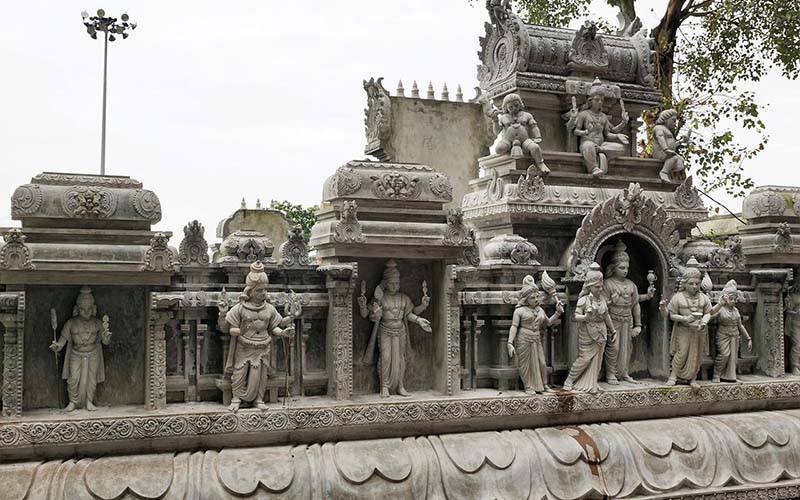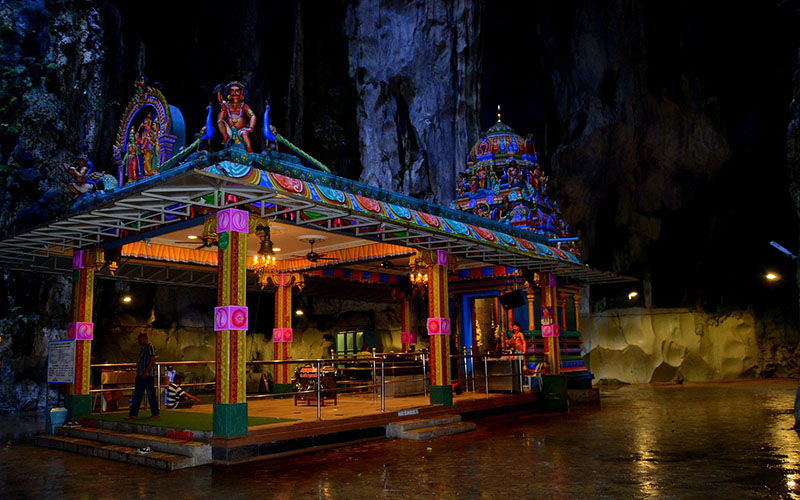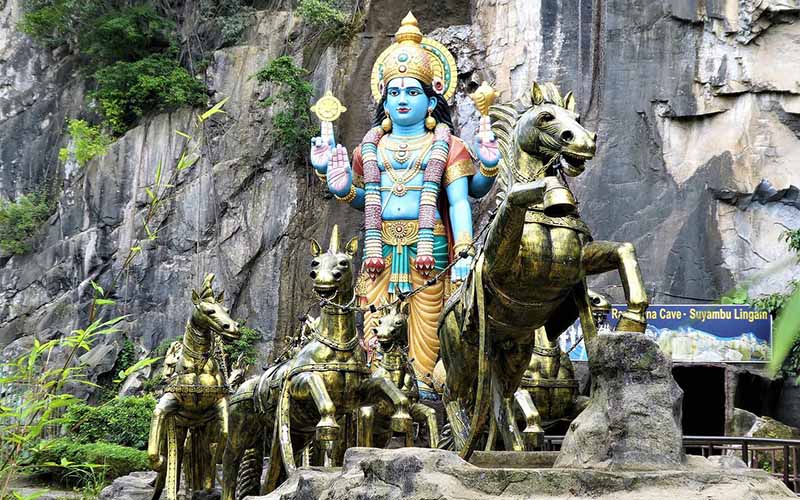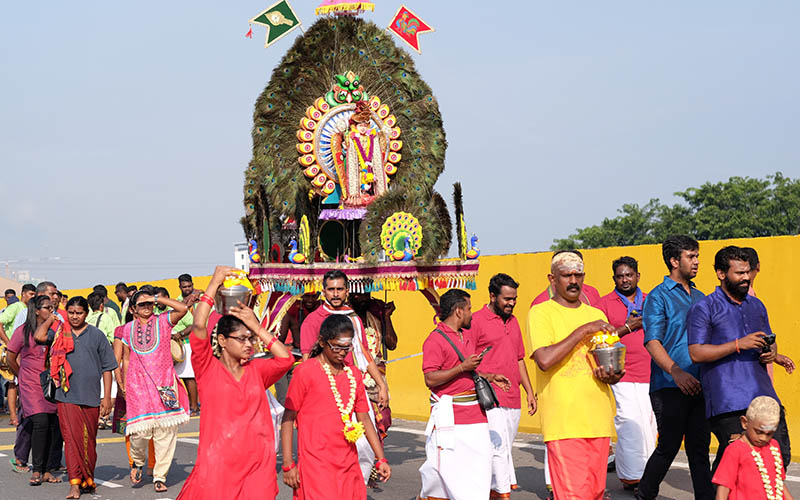Malaysia, a fascinating country in Southeast Asia, known for its beautiful historical landmarks and rich cultural heritage, attracts many tourists. Travelers are mesmerized by this tropical island country for its remarkable cities, dense rainforests, gorgeous white sand beaches, picturesque islands, wild jungles, theme parks, adventure activities, shopping, and cuisine. Explore the tea plantations at Cameron Highlands or enjoy scuba diving at Redang Island. The Borneo Rainforests and the beaches of Langkawi make this country a favorite destination for families. Kuala Lumpur, the capital, has colonial buildings and architectural remains like Bukit Bintang, and the most popular attraction is the famous 451-meter-high Petronas Twin Towers.
Amongst all these attractions, the Batu Caves are considered special. The famous Hindu shrine, Batu Caves, located in the Selangor region of Malaysia attracts a large number of devotees. But before you plan a trip to Batu Caves, you must apply for a Malaysia tourist visa. You can either get the Malaysia visa electronically online with an ENTRI or apply for the visa at the Malaysian Embassy via the visa application centers.
Where is Batu Caves?
Batu Caves is a cohort of small caves situated in Gombak District of Selangor State of Malaysia. It consists of several caves, the Temple Cave, Art and Museum Cave, dark Cave, and several smaller ones.
How to get to Batu Caves
From Kuala Lumpur Airport, it is 73 km away which gives you plenty of modes to choose from. You may either go through a bus, taxi or a train. Taxi is the easiest option which will directly take you to Batu Caves for around an hour.
If you opt for a Bus, you may have to change 2-3 buses as there is no direct bus to the area. Another hectic option could be via 2 trains. First hop on to the KL Ekspres towards City and then change to the KTM Seremban Line and you are there!
How Long does a trip to Batu Caves Take?
Considering the 272 stairs and the time you spend admiring the place, it will hardly take 2 hours to finish having toured the Batu caves and have taken all the blessings from this majestic place. But if you do not want to spend much time in line to worship the deity, visit in the morning to encounter less crowd.
Best Time to Visit Batu Caves
You should visit on weekdays to avoid crowds and long queues. The operating hours of Batu caves are from six in the morning to nine in the night. This means the perfect time to visit is either in the early morning or during the evening.
History of Batu Caves

As you must be aware the temple at the caves is dedicated to a Hindu deity, Lord Murugan. But how did a Hindu deity and his temple end up in Malaysia? Well during the 19th Century, when trade between South Asian countries was at its peak and the Gamok area was known for its limestone Caves, an Indian Tamil trader named K. Thamboosamy Pillai saw these 400 MIllion-year-old caves and suggested dedicating the place to be built as a Hindu Shrine in 1890 due to the ‘vel’ shape of the caves.
The shape is considered to symbolize Lord Morugan’s spear gifted by his mother Parvati, which he used to defeat the Asuras (Demons). The temple is also among the 10 Murugan temples all around the world where 6 of them are in India and the rest in Malaysia itself. Pillai also installed the giant golden statue of Lord Murugan as you must have seen in movies or the internet. The temple was completed in 1920 and was renovated latest in 2018.
The Batu Caves and Temple

Situated thirteen kilometers north of Kuala Lumpur stands a monument that seems to have been built by the gods themselves: The Batu Caves. It derives its name from Sungai Batu or Stone River that flows past the hill. The Batu Caves Temple, one of Kuala Lumpur’s most frequented tourist attractions, is a limestone hill comprising three main caves and several smaller ones. Cathedral Cave, the largest cave, houses several Hindu shrines under its hundred-meter high arched ceiling. There are two other caves temples at the foot of Batu Hill: the Art Gallery Cave and the Museum Cave, which house numerous Hindu statues and paintings. The golden-colored massive statue of Lord Murugan is located at the steps entrance and stands 140 feet (42.7m) tall and is the world’s tallest statue of Lord Murugan. It took three years to construct the Lord Murugan statue under the guidance of Thiruvarur Thiagarajan Sthabathy from Tamil Nadu. The statue was first unveiled in January 2006 during the Thaipusam festival.
Different Sights and Attractions at Batu Caves

- In 1920, wooden steps were made for easy climbing of devotees to get to the Temple cave or Cathedral Cave that sits atop a mountain. With more devotees came more offerings, and the wooden steps were eventually reconstructed and replaced with the two hundred and seventy-two concrete steps of today. In 2018, the concrete steps that led to the temple got painted in various colors. It feels like you are ascending a rainbow into the chambers of Gods. The colorful Batu Caves steps instantly became viral on social media and are a spot for picture-worthy shots.
- The Ramayana Cave, another attraction at Batu Caves, has many statues of Hindu Gods that depict the story of Ramayana. The giant statues of Hanuman and Kumbhakarna leave every visitor spellbound.
- Explore the Dark Cave, which is home to the rarest spider species, the Trapdoor Spider. The dense population of bats, flatworms, cockroaches, rock formations, and potholes amidst rocks add up to the adventure quotient of the Dark Cave.
- Witness the exhibits at the Cave Villa, located at the foot of the Batu Caves. There are two caves: one cave has beautiful exhibits of paintings and poems of Hindu poets, and the other cave has exhibits of live reptiles like snakes enclosed in a glass tank.
Festivals Celebrated at Batu Caves

Batu Caves hold a special place among locals due to the annual Thaipusam festival, during the Tamil month of Thai, which falls in January or February. Thaipusam festival is celebrated in commemoration of the triumph of good over evil and attracts millions of devotees every year. This festivity is honored by Hindus from Malaysia and neighboring Singapore. Funfairs, lights, devotional songs, the crowd dressed in yellow clothes, and parades of colorful ‘kavadis’ dancing away like peacocks are some of the highlights of the festival.. Some devotees fulfill their vows by having their bodies pierced by Vels in different sizes. The entire area echoes with chanting of ‘Vel Vel’; ‘Vetri Vel; Vera Vel’; and ‘Arohara’ to get the blessings of Lord Murugan.
Batu Caves is a pivotal place of worship for many. Devotees from all over the world come every year for special vows and prayers. Remember to follow a dress code when visiting the Batu Caves, as short pants and skirts above the knees are not allowed inside the temple. Avoid carrying food as it could invite monkeys. This temple is a must-visit destination in Malaysia for its mesmerizing beauty and breathtaking nature.
Must Read: Explore Kek Lok Si Temple Malaysia
 Featured
Featured
 Featured
Featured
Why is Batu Caves Worth Visiting?
If you are a peace-seeker, natural beauty enthusiast, or just love getting to know about various cultures and traditions of the world, visiting Batu Caves is worth your time.
A must-mention is the beautiful temple located at the hill which you climb through hundreds of colorful stairs to eventually end up in a luminous limestone cave, learning about the rich Hindu culture and their gods through the Art caves and Museum caves to make it another educational endeavor.
Dress Code and Respect.
Being a Hindu Temple, Batu Caves and its administration have to maintain the dignity of the place and hence have provided the dress code for everybody visiting there. Simply put your knees and shoulders must be covered i.e. you can either wear long trousers or skirts or any traditional attire that covers the parts the management requires.
Be careful as they will check the same while you enter. However, if you’ve worn something else, you can buy or borrow a sarong (a long piece of cloth) to help you cover yourself and respect their culture.
Batu Caves Timings
Batu Caves opening hours are from 6 AM to 9 PM. The caves are open twenty-four hours on all days of the week. The timings of the Batu Caves Temple are the same as the opening hours of the caves. But it is better to visit this attraction before ten in the morning or after five in the evening.
Places to Visit Near Batu Caves
You should visit the places mentioned below to ensure a full day of enjoyment after covering the Batu Caves.
1. Petronas Twin Towers
Located nearby in Kuala Lumpur, The Petronas Twin Tower is a historical landmark as one of the tallest twin skyscrapers in the world. It is a 451.9 m tall 88-storey building with malls, offices, and concert halls as attractions.
2. Aquaria KLCC
The Kuala Lumpur City Center embraces within itself one of the best oceanariums in the world having more than 5,000 land and aquatic animals for show.
3.Selayang Hot Spring Pool
This place is a turquoise-colored natural hot spring with 4 such pools of different temperatures. It is located near the Batu caves and perfect for relaxation.
4. Sunway Lagoon Theme Park
Spread over 88 acres, this ultimate theme park is another thrill destination. With exhilarating rides to water park, wildlife park, and amusement park, Sunway Lagoon must be on your list.
Highlights of Batu Caves
- The glorious golden 42.7 meter-tall statue of Lord Murugan is also known as the world’s second tallest Murugan Statue.
- Ramayana Cave depicts the holy epic-tale of Ramayana through its colorful statues.
- Dark Cave is a conservation site for various insect and reptile species and endangered fauna.
- The gigantic 15-metre-tall Lord Hanuman Statue located left at the entrance of the Bati Cave depicts his passionate love and honor for his beloved Lord Rama and Goddess Sita.
- Monkeys have been another frequent visitor of the place, with the monkey god (Hanuman) himself near the temple, the presence of monkeys makes it more mysterious to observe.
- You can even try guided rock climbing on these concrete limestone rocks operating on its northern side.
Restaurants Near Baru Caves
After having explored such a beautiful place, one must be hungry right? Here is a list of some restaurants near The Baru Caves you may consider visiting.
1. Oh Yeah banana Leaf, Batu Caves
If you were intrigued by the Hindu culture and traditions after your visit, why not consider Indian food too? Oh Yeah banana leaf is known for impeccable service, tasty Indian cuisine, and especially the banana-leaf curry.
2. Hang Wan Restaurant
Tired of wandering around and craving some homemade food? Hang Wan is a Chinese seafood restaurant that gives you exactly what you need. Don’t forget to try their famous Feizhou Fish though!
3. Rani Vilas Restaurant Shop
For vegetarians, this is the right stop! They serve delicious and spicy Indian vegetarian food, from North Indian to South Indian, it has everything you crave.
4. Gua Lepak
This restaurant built within a limestone cave is not just a restaurant but a hanging spot with a gaming zone as well, Gua lepak serves you both food and comfort through its 17 different food stalls.
5. Restoran Sin Kee
For your Chinese cravings, visit here to satisfy your hunger with your family and for a good ambiance, noodles, and hotpot.
Tips for Visiting Batu Caves
- Beware of the monkeys and do not feed them or try to indulge with them in any way.
- Follow the dress code and dress lightly to avoid discomfort during crossing caves.
- Wear slippers/flip flops or Shoes to climb up the stairs comfortably.
- Booking a tour in advance can give you a guided and better understanding of the place.
Conclusion
For those searching for some peace, learning, spiritual experience, and tranquility, Batu caves are most appropriate to give a thought of. It welcomes you to pay respect, give offerings, and learn about the culture and has something for everybody visiting there. Make sure to include Batu caves on your Malaysia trip list.
